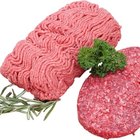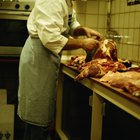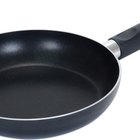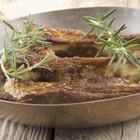MarianVejcik/iStock/GettyImages
Although they both come from the same part of the cow, ribeye steak and a standing rib roast are cooked and eaten in very different ways. Ribeye steak, along with other steaks, is the second most-popular cut of beef served in American homes, with ground beef coming in first. A standing rib roast, on the other hand, is a special treat, served mostly at holiday meals and available at a much higher cost than ribeye steak.
The Cuts
Both ribeye steaks and standing rib roasts are tender cuts of meat from the rib section. They come from along the top of the cow's back, behind the neck and the less tender chuck. Behind the rib section is the most tender part of the cow, the tenderloin and top loin sections. The standing rib roast contains at least three ribs, while the ribeye steak is a boneless cut from the center, or eye, of the rib roast.
Nutritional Details
Because ribeye steaks come from the same place as a standing rib roast, both cuts contain the same nutrition in a 3-ounce serving -- 166 calories, with 2 grams of saturated fat and 3 grams of monounsaturated fat, 25 grams of protein,1.6 milligrams of iron and 4.7 milligrams of zinc. Both cuts also provide about 44 percent of your daily requirement for vitamin B12 and 22 percent of the requirement for B6.
Cooking Ribeye Steak
Individual ribeye steaks are best pan-fried, grilled or broiled, because they cook fairly quickly. The steaks are done in seven to 10 minutes on each side, depending on the thickness. Although the U.S. Department of Agriculture recommends cooking all steaks and roasts to an internal temperature of at least 145 degrees Fahrenheit for medium-rare, you can safely cook rare steaks to 125 degrees F, because any bacteria present are on the surface of the meat and will be killed by direct heat.
Cooking a Roast
Roasting adherents fall into two camps -- those who roast at high temperatures and those who don't. A roast cooked at 375 degrees F takes about for 18 to 20 minutes per pound. A low-temperature option requires browning the roast on the stovetop, then cooking it in a 200-degree oven for about 30 minutes per pound. In either case, let your roast rest for 20 to 30 minutes before carving, so the juices reabsorb into the meat.
Related Articles

Different Cuts of Steak

What Cuts of Meat Are Used for Ground ...

Cuts of Meat From a Front Quarter of ...

What Is the Difference in Top Sirloin & ...

How to Cook Kobe Steaks

How to Cook Pork Loin

Does a Rib Eye Have a Filet in It?

Filet vs. Strip vs. Sirloin

How to Cook Deer Sirloin

How to Cook Beef Top Round Pot Roast

What Is the Difference Between a Prime ...

How to Sear Ribs

How to Get Skirt Steak Tender

How to Make a Blackbuck Antelope Roast
How to Cook Boneless Top Chuck Steak in ...

Which Cuts of Meat Come From the Front ...

How to Cook a 15-Pound Rib Roast

What Is Sirloin Roast?

How to Cook Boneless Country Spare Ribs
How to Cook Buffalo Fillet
References
- The Deluxe Food Lover's Companion; Sharon Tyler Herbst and Ron Herbst
- Beef It's What's For Dinner: Ribeye Steak
- U.S. Department of Agriculture: Safe Minimum Internal Temperature Chart
- Saveur: Ojo De Bife Con Chimichurri (Whole Boneless Rib Eye with Chimichurri)
- Sunset: Standing Rib Roast
- The Science of Good Cooking; Editors at America's Test Kitchen and Guy Crosby
- Beef It's What's For Dinner: Nutrition
Writer Bio
Susan Lundman began writing about her love of cooking, ingredient choices, menu planning and healthy eating after working for 20 years on children's issues at a nonprofit organization. She has written about food online professionally for ten years on numerous websites, and has provided family and friends with homemade recipes and stories about culinary adventures. Lundman received her M.A. from Stanford University.